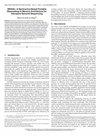Enhancing the Reach and Reliability of Quantum Annealers by Pruning Longer Chains
IF 1.4
3区 计算机科学
Q4 COMPUTER SCIENCE, HARDWARE & ARCHITECTURE
引用次数: 0
Abstract
Analog Quantum Computers (QCs), such as D-Wave's通过修剪长链提高量子退火器的覆盖范围和可靠性
模拟量子计算机(QC),如 D-Wave 的量子退火器(QAs)和 QuEra 的中性原子平台,在计算能力上可与数字量子计算机相媲美。现有的 QA 拥有超过 5,700 个量子比特,但它们的单指令操作模型无法使用 SWAP 操作使物理距离较远的量子比特相邻。取而代之的是,QA 使用嵌入过程将多个物理量子比特链在一起,代表了具有更高连通性的程序量子比特,并将 QA 的有效容量最多降低了 33 倍。我们观察到,嵌入后,近 25% 的物理量子比特仍未使用,被困在链之间。此外,我们还观察到了链长度的 "幂律 "分布,其中少数占主导地位的链拥有更多的量子比特,从而对量子比特利用率和隔离度产生了更为显著的影响。利用这些洞察力,我们提出了 Skipper,这是一种软件技术,旨在通过跳过优势链并用两个测量结果替代其程序量子比特来增强 QA 的容量和保真度。通过使用 5761 个量子比特的 QA,我们观察到通过跳过多达 11 个链,容量增加了多达 59%(平均 28%),误差减少了多达 44%(平均 33%)。
本文章由计算机程序翻译,如有差异,请以英文原文为准。
求助全文
约1分钟内获得全文
求助全文
来源期刊

IEEE Computer Architecture Letters
COMPUTER SCIENCE, HARDWARE & ARCHITECTURE-
CiteScore
4.60
自引率
4.30%
发文量
29
期刊介绍:
IEEE Computer Architecture Letters is a rigorously peer-reviewed forum for publishing early, high-impact results in the areas of uni- and multiprocessor computer systems, computer architecture, microarchitecture, workload characterization, performance evaluation and simulation techniques, and power-aware computing. Submissions are welcomed on any topic in computer architecture, especially but not limited to: microprocessor and multiprocessor systems, microarchitecture and ILP processors, workload characterization, performance evaluation and simulation techniques, compiler-hardware and operating system-hardware interactions, interconnect architectures, memory and cache systems, power and thermal issues at the architecture level, I/O architectures and techniques, independent validation of previously published results, analysis of unsuccessful techniques, domain-specific processor architectures (e.g., embedded, graphics, network, etc.), real-time and high-availability architectures, reconfigurable systems.
 求助内容:
求助内容: 应助结果提醒方式:
应助结果提醒方式:


